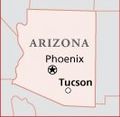Tucson
 From Conservapedia
From Conservapedia Tucson is a city of Arizona located 118 miles SE of the state capital Phoenix. It has a population of 526,000.

The region was first settled by Native American Indians approximately 12,000 years ago. Later, in the 18th century, Spanish missionaries established a mission and a settlement that would later become Tucson. The town became a part of the United States in 1854, with the Gadsden Purchase, which allowed the railroads to connect with the Midwest and California.
The University of Arizona was established in 1885 in Tucson. Tucson was capital of Arizona for some time and until about 1930, Phoenix was smaller than its sister city.
Contents
- 1 20th century
- 1.1 Tourism
- 1.2 Hospitals
- 1.3 Chinese
- 1.4 World War II
- 1.5 Titan
- 1.6 Merchandizing
- 2 Further reading
- 2.1 References
20th century[edit]
The population rose from 7400 in 1900 to 13,900 in 1910, 20,000 in 1920, and 37,000 in 1940. In 2006 the population of Pima County, in which Tucson is located, passed one million while the City of Tucson's population was 535,000.
Tourism[edit]
Tucson became an nationally famous winter tourist site during the 1920s. Troubled by economic stagnation, the Chamber of Commerce, the Tucson Sunshine-Climate Club, and the Arizona Polo Association did market surveys and inaugurated magnet events, like La Fiesta de los Vaqueros; they even built tourist facilities, like El Conquistador Hotel. The efforts were successful and tourism became a mainstay of the economy by 1930, and remains so into the 21st century.[1]
Hospitals[edit]
In 1919, Lieutenant Neill MacArtan of the Army Medical Corps arrived in Tucson, Arizona, looking for a sanatorium site. He found nearly 700 veterans scattered in squalid conditions throughout the area and commenced a decade's struggle to build a southwestern veterans hospital. Tucson's success is the story of city officials and citizens volunteering, organizing, battling other contenders like Livermore, California, and lobbying Congress. Despite MacArtan's death from tuberculosis in 1922, Veterans Administration Hospital Number 51 opened at Pastime Park in 1928. Many TB sufferers and veterans who had been gassed in World War I and were in need of respiratory therapy came to Tucson after the war because of the clean, dry air.[2]
Chinese[edit]
Chinese and Mexican merchants and farmers transcended racial differences to form 'guanxi,' kith relations of friendship and trust. Chinese leased land from Mexicans, operated grocery stores, and aided compatriots attempting to enter the United States from Mexico after the Mexican Revolution in 1910. Chinese merchants supplied General John Pershing's army in its expedition against Pancho Villa. Successful Chinese in Tucson led a viable community based on social integration, friendship, and kinship.[3]
World War II[edit]
During World War II (1941–45) Mexican-American community organizations were very active in patriotic efforts to support American troops abroad, and made efforts to support the war effort materially and to provide moral support for the young American men fighting the war, especially the young Mexican-American men from local communities. Some of the community projects were cooperative ventures in which members of both the Mexican-American and Anglo communities participated. Most efforts made in the Mexican-American community, however, represented localized American home front activities that were separate from the activities of the Anglo community.[4]
Mexican-American women in Tucson organized to assist their servicemen and the war effort during World War II. An underlying goal of the Spanish-American Mothers and Wives Association was the reinforcement of the woman's role in Spanish-Mexican culture. The organization raised thousands of dollars, wrote letters, and joined in numerous celebrations of their culture and their support for Mexican-American servicemen. Membership reached over 300 during the war and eventually ended its existence in 1976.[5]
Titan[edit]
Titan II Missile Complex 571-7, now the Titan Missile Museum was in service from 1963 through 1987. The Titan II's were the largest, most powerful intercontinental ballistic missiles developed by the United States. When they were phased out, the base located 25 miles south of Tucson was leased out to serve as a nonprofit museum; 53 other bases were dismantled.[6]
Merchandizing[edit]
Jacome's, a family-run department store in downtown Tucson survived for eighty years before succumbing to competition from the suburbs in 1980. Carlos Jacome opened the store as La Bonanza in 1897, and he and his sons and grandsons continued to run it in a way that reflected their Mexican-American heritage. In its last few years, Jacome's tried several times to open branch stores, but could not borrow the necessary capital. The Jacome family resolutely turned down all offers by national chains to buy the store, and closed down the business in 1980.[7]
Further reading[edit]
- Logan, Michael F. Desert Cities: The Environmental History of Phoenix and Tucson. (2006). 240 pp.
- Sheridan, Thomas E. Los Tucsonenses: The Mexican Community in Tucson, 1854-1941. (1986). 327 pp.
References[edit]
- ↑ Alex Jay Kimmelman, "Luring the Tourist to Tucson: Civic Promotion During the 1920s," Journal of Arizona History 1987 28(2): 135-154
- ↑ Alex Jay Kimmelman, "Pastime Park: Tucson's First Veterans' Hospital," Journal of Arizona History 1990 31(1): 19-42,
- ↑ Grace Peña Delgado, "Of Kith and Kin: Land, Leases, and 'Guanxi' in Tucson's Chinese and Mexican Communities, 1880s-1920s," Journal of Arizona History 2005 46(1): 33-54,
- ↑ Christine Marín, "Mexican Americans on the Home Front: Community Organizations in Arizona During World War II," Perspectives in Mexican American Studies 1993 4: 75-92
- ↑ Julie A. Campbell, "Madres Y Esposas: Tucson's Spanish-American Mothers and Wives Association," Journal of Arizona History 1990 31(2): 161-182,
- ↑ Marshall Krantz, "Postfix: the Museum of Modern Death," American Heritage of Invention & Technology 1992 8(2): 63-64,
- ↑ June Webb-Vignery, "A Grande Dame Stripped of Her Jewels: the Last Days of Jacome's Department Store," Perspectives in Mexican American Studies 1992 3: 53-72,
Categories: [Arizona] [Arizona Cities and Towns] [Urban History] [Western United States]
↧ Download as ZWI file | Last modified: 03/28/2023 17:50:18 | 131 views
☰ Source: https://www.conservapedia.com/Tucson | License: CC BY-SA 3.0
 ZWI signed:
ZWI signed: KSF
KSF